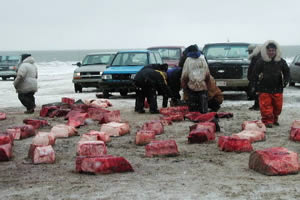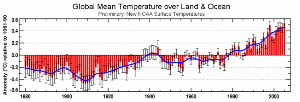
 |
Climate change threatens Far North healthMarch 29, 2007Courtesy of Far North Science 
"Every day, as we know, news reports provide more evidence of the consequences of global warming from around the planet," said Pam Miller, an organizer of the teleconference and executive director of Alaska Community Action on Toxics. "We also know that the arctic is warming faster than other parts of the world, accompanied by melting permafrost, thinning sea ice, increasing storm surges and coastal erosion. . Some Alaska coastal communities are facing disruption and expensive relocation." Most vulnerable will be the residents of rural villages, most of them Natives and First Nations people, who rely on subsistence food and local resources to make a living. When contaminants get transported to the North on changing air and ocean currents, they end up in the food chain and migrate meal to meal into the bodies of people. When animal populations crash in number or shift to new habitat, local people must spend more time and resources to gather food. "They are the most highly dependent subsistence population in the world," said Dr. James Berner, science director in the Division of Community Health of the Alaska Native Tribal Health Consortium. "It is one of those areas where the changing climate has a direct daily impact on the lives of the people who live in it." The solution? Health providers must take action to spread the word and work to undercut human emissions that contribute to greenhouse gas concentrations, the panelists said during a teleconference this week with journalists and health officials around the country. Other speakers were Deborah Williams of Alaska Conservation Solutions, Dr. Michael Bradley and engineer John Warren of the Alaska Native Tribal Health Consortium.
"The debate about whether global environmental change is real is now over; in its wake is the realization that it is happening more rapidly than predicted," the scientists wrote." These changes constitute a profound challenge to human health, both as a direct threat and as a promoter of other risks. We call on health care providers to inform themselves about these issues and to become agents of change in their communities." The article concludes: Humans are capable of social evolution, which allows us to rethink our actions and make relatively rapid changes that could help to lead to a stabilization of the global environment and human health risks. In the 1960s, America achieved a landing on the moon thanks to a concerted national commitment with timely leadership. We are once again called upon to rise to that level, but this time, rather than merely leaving our planet, we must try to save it. While climate change triggers many indirect effects - spreading diseases further north like West Nile Virus and giardia - Berner pointed out that people shouldn't forget that air temperature change can directly hurt or kill people. 
Rising Global Temps / NCDC Hurricane Katrina killed about 1,000 people when it hit New Orleans. But a heat wave in Europe the same summer killed about 25,000 people over 35 days, particularly in France, where health officials hadn't prepared for such sustained increases in air temperature. "It was like five Hurricane Katrinas every week for five weeks," Berner said. |
|